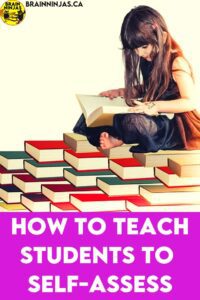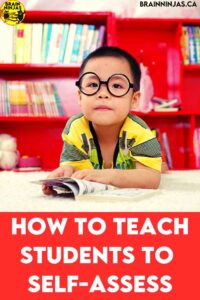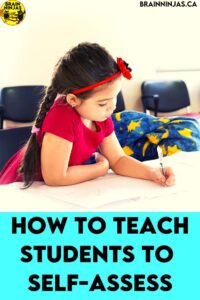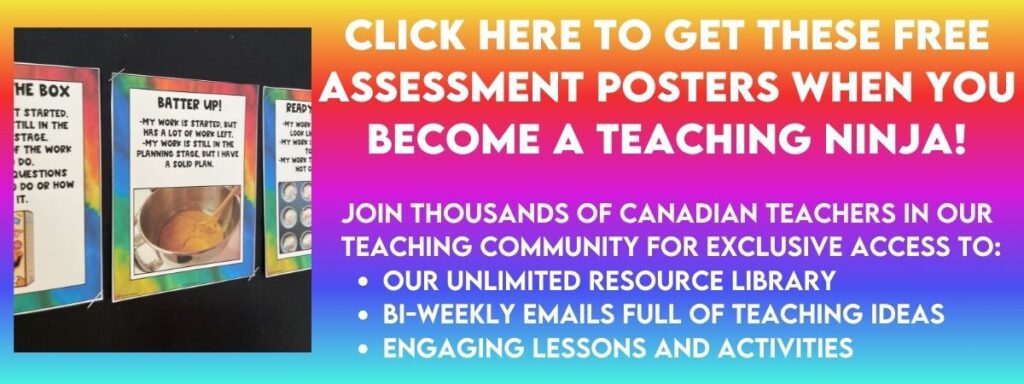
How often do your students tell you they are all done with their work or assignment and the second you look at it, you notice they’ve missed a huge part of the task? Teaching your students to self-reflect accurately is very challenging because students are usually unrealistic. They are either too hard on themselves or clueless about how little they’ve done.
Teaching students to reflect on their work, accept feedback and modify their work to improve its overall quality takes time and a lot of patience. Keep reading to learn more about how we teach our students to use self-evaluation as a tool for improving their own work.
You need this lesson if your students:
- are constantly asking if they are “done”
- dents have low self-esteem and never think their work is good enough
- think their work is awesome, but it’s barely meeting your standards (or is not meeting them at all)
Students cannot self-assess unless the requirements are clear.

Often when we ask students to reflect on their work to make sure they are done or have done their best, we aren’t clear with students about exactly what we want from them. This makes it even more difficult for students to accurately assess their own work.
When you give students an assignment be very clear about the requirements for completion. For example, students cannot say they are done unless they have finished “these” things. Requirements are the non-negotiable items that must be completed for a student to say they have finished the task.
Items that fit well into the requirements category are:
- name on it (where the name goes)
- number of words, sentences, paragraphs or pages
- number of pictures, images, charts, diagrams or graphs
- whether or not things are coloured, legible or fill the page
- specific use of a skill (capital letters, punctuation, use of a specific vocabulary word)
- number of questions answered
Basically, anything that can be answered with a yes or no where items can be counted or verified goes into the requirements category. Most of the time these will be an amount, but not a specific quality. A checklist is the most common way to assess requirements.
So, if your assignment is to write a short story that includes a coloured picture then it’s easy for anyone who looks at the page to see whether or not that is done. Requirements are not graded for quality. Instead, they are looked at for completion. Requirements fit perfectly on a checklist where students can check off whether or not they’ve done each of the steps or items that are required.
If you have students working at different abilities, you can adjust the requirements for students specifically based on the task.
Students cannot self-assess unless the criteria is clear.

Criteria is how well a student does the task. This is how you can actually assess the quality of work. You can give students ideas about what will get them the best mark.
When you are coming up with the criteria for an assignment, you need to have an idea of what you expect from all your students and then think about what students will be able to do to exceed that expectation. If there is no way to exceed, then it is probably a requirement. Criteria need to have levels of achievement. A rubric is the most common way to assess criteria.
For example, if you expect students to write four sentences, then that is the requirement. But, the criteria might be the ability to write a complex sentence that uses details. How complex is the sentence? How many and what is the quality of the details? That is the criteria.
Let’s look at an example of requirements and criteria on a math worksheet. The requirement is that each question is answered legibly. The criteria are that each question shows all the steps to each equation, explains the thinking process and is written neatly.
But this is such a broad way of thinking, how will it help students?
We struggled with this for a long time, but eventually thanks to our students we came up with a clever way for all students to understand how criteria and requirements are connected.
Criteria and requirements are connected-but not the same.
Let’s use a yummy analogy to talk through the requirements and criteria. If you were baking some cupcakes, there would be some basic requirements in order to call your baking project a cupcake. You would need to combine several ingredients to make some batter. You would have to use those little cupcake pan liners and a special pan to put the batter into. These cupcakes would need to bake in an oven for a certain amount of time. Then you would have a basic cupcake, or we could say you’ve met the basic requirement. So, in order for a cupcake to be called a cupcake, it would need to be made from batter that is baked.

No argument there.
But, a cupcake that is baked but not frosted or decorated is just a boring old cupcake. Nobody wants that.
So, the assignment is done, but it is just the basic, plain old boring assignment. It does not exceed the expectations for the task. It is the bare minimum.
For some tasks, this is fine. Not all tasks that we complete in school each day have a spectrum of criteria. They are either done or not done.
But when we work on more complex tasks, we start to get into the criteria. Is the cupcake frosted? Does it have fancy decorations that make it even more delicious? This is criteria. It is how well something is done.
How do we teach students to self-assess their own work?
We use The Cupcake Scale with our students because it is a tangible way to express to our students whether or not their work is ready to be handed in. The first time we introduce the Cupcake Scale, we teach it as a lesson. Gather up student exemplars (not current or identifiable students) or make up some samples that show different levels of completion.
Introduce each of these concepts using an exemplar to demonstrate what that work might look like. We hang up each of the posters from this set as we explain the definition. Once we’ve gone through each of the levels, we add exemplars that students can use to help them assess their own work.
If you struggle with giving students meaningful feedback about their work, you should read our post: How to Give Amazing Feedback.
Still in the Box
This is the stage where the assignment has just been given. There hasn’t been any plans on how to make the cupcakes (the task) yet, but there is a basic idea about what is going to be made or created.
When you show exemplars of this stage, you might talk about the fact this is just the stage when the teacher has said what to do, but there hasn’t been any real work yet. Students might have a blank piece of a paper or a blank worksheet or even just an idea.
Batter Up!
This is the stage where students collect all their materials and get started making or creating their product. They might follow some directions and add some of their own thoughts. At this stage, there is a start, but it doesn’t really look like cupcakes yet.
Exemplars of this work might be the beginning of a first draft of writing, collected art materials, a quick sketch or an outline of the steps to do (sort of like a recipe).
Ready to Bake
Now the batter is sitting in the little cups and is ready to put in the oven. There is a clear plan about what is going to happen and after a little bit of baking (working) the project or task will have its requirements met.
Exemplars for this stage might look like a rough draft, a drawing that isn’t coloured or a basic map that needs labels. It looks like a project but doesn’t have any finishing touches and is just about ready.
Baked
Now this is a cupcake. It has met all the requirements to be finished, but it has only met the expectations. Nothing makes this cupcake special. This is the stage when we encourage students to think about what they can do to make their work better. Give students feedback that makes them think about how they can exceed the expectations for the assignment.
Exemplars at this stage look finished but have nothing special about them. It could be a basic paragraph, a simple chart/diagram or a complete project. These would be acceptable to hand in to be assessed because they have made the requirements to be completed. They do not exceed the expectations of the assignment.
Frosted
This is where the magic happens for cupcakes. This is what makes a cupcake go from done to delicious. When we talk to our students about “frosting their work” we mean we want them to look at how they can make their work stand out and make us cheer for how great it is.
Exemplars for this category are projects that are not only completed but exceed expectations, whether that is extra things done, exceptional craftsmanship, or overly detailed. Students should be able to see the difference between work that is just completed and work that exceeds all the other work. This is the level you want your students to strive for.
Where can I get a copy of The Cupcake Scale?
Do you want your own copy of The Cupcake Scale? Just follow the link to grab it (this image is also linked to it). It is part of our Resource Library, but we’ll send it to your inbox. When you sign up for our ninja news, you get the Cupcake Scale and receive unlimited access to our Resource Library full of different tools you can use in your classroom! If you are already on our mailing list, you can find The Cupcake Scale in the Resource Library.
Why do I want students to self-assess?
Well, you don’t want your students to self-assess so they can write their own report cards (wouldn’t that be amazing?). Students who can self-assess or reflect on their own work are able to figure out what they are missing, what they can do to improve or where they went wrong. They can accept feedback and make changes to improve which is a life skill that will help them throughout their lives no matter what career they choose.
We don’t want students to self-evaluate at the end of the project. We want them to learn to reflect as they are working on a project so they can adjust what they are doing as they work.
Be transparent with your students about your expectations with their assignments. If you aren’t clear what you want from them, they aren’t going to be able to meet or exceed your expectations.
Of course, we recognize, that not every task in every school day needs to have a high level of self-reflection, but if you start right from the beginning of the school year, by Christmas, your students will be able to understand your expectations BEFORE you even finish giving them tasks.

Wait a minute, my class is full of different levels of abilities. How do I use this with them?
Uh, exactly the same way. To differentiate for your different learners, set out your expectations (the requirements and the criteria), whether that is to write a sentence or a page doesn’t matter. Students can meet or exceed your expectations for that same assignment based on what your requirements are for each student.
So in other words, change the assignment, but don’t change the expectation for your students to exceed your expectations. Be consistent with your students and then let us know how it goes by leaving a comment for us below.







